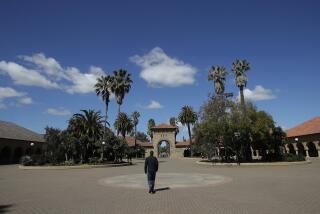How Harvard could share the wealth
HARVARD University has an endowment of about $26 billion, which exceeds the gross domestic product of more than 100 nations and is greater than all the physical assets of McDonald’s Corp. It is the richest university in the country; in fact, a few years ago, the Boston Globe reported that Harvard’s endowment was greater than that of any nonprofit institution in the world except the Catholic Church.
So why then does Harvard have one of the lowest percentages of low-income students of any Ivy League college? And why does it charge an exorbitant $41,675 a year in tuition and fees to undergraduates -- a number not much less than the U.S. median household income of $44,389?
Because it can, of course. But does it have to? Here’s a radical suggestion for Derek Bok, who is being brought back as president of the university after Lawrence H. Summers resigns in June: Why not make Harvard free?
That’s right. Bok -- who has been a lucid critic of the corrupting influence of big money on universities -- can, with a single gesture of unassailable virtue, light a fire under the increasingly decadent realm of elite colleges, instantly restoring Harvard to a position of moral leadership in society.
Perhaps that sounds unrealistic. After all, no other private university in the country offers any such deal. But Harvard could do it with hardly a dent to its pocketbook -- and along the way, it could send a potent message about egalitarianism, excess and the importance of education for all.
Consider the numbers: Harvard currently has 6,600 students. Footing the entire bill for all its undergraduates would likely run close to $275 million a year (an additional net cost of only about $190 million, because the university already provides about $85 million in scholarships to undergraduates who qualify for need-based aid).
Of course, $190 million sounds like a lot to most of us, but it is less than 1% of the school’s endowment, and only a small fraction of the endowment’s $3-billion growth last year. What’s more, Harvard spent 4.5% of its endowment in the 2005 fiscal year; even with the additional burden of paying for every single undergraduate, it would remain well within its own self-imposed comfort zone of an annual withdrawal of 5% of the endowment. (And who knows? Maybe such a worthy move would even prompt additional gifts from alumni and others, who last year donated about $639 million to the university.)
Why should Harvard take such a costly, unprecedented step? Partly because the percentage of low-income students enrolling at the nation’s top colleges has been falling for the last decade. According to a 2004 report by the Century Foundation, only 3% of students at the nation’s 146 most selective colleges come from the nation’s lowest socioeconomic quarter; 74% come from the richest quarter. In other words, as Richard Kahlenberg of the Century Foundation put it recently, if you wander around one of the nation’s selective campuses, you are 25 times as likely to run into a rich student as a poor one.
Harvard is a perennial bottom-dweller in enrolling low-income students. A study by higher-education researcher Thomas G. Mortenson reported that only 7% of Harvard undergraduates receive the federal Pell Grants that exist for low-income students (Pell Grants are considered the best measure of how many low-income students attend a school); U.S. News & World Report says the number is 11%. In either case, it is a far lower percentage than other elite private universities, such as Columbia, Caltech or Stanford.
Two years ago, Summers took action to make Harvard more accessible. He declared that parents of undergraduates with family incomes less than $40,000 a year would no longer have to pay anything for their children’s Harvard education. The expected payment from families with incomes under $60,000 would be cut greatly as well.
Summers said his initiative sent “a powerful message that Harvard is open to talented students from all economic backgrounds.” The university reported that the enrollment of students in those income brackets rose 18%. But the 18% growth, when you do the math, means only an additional 45 students.
Harvard’s message needs to be more powerful -- at least as powerful as one ought to expect from an elite, 370-year-old, $26-billion institution. Dropping tuition, room and board charges for all students would be a gesture worthy of the institution.
Private universities continue to set higher and higher prices for undergraduates even as their endowments grow to record levels. Although Harvard’s move would be unlikely to persuade most schools to drop tuition and fees altogether, it would certainly force them to rethink their priorities. Its closest rivals would certainly be under pressure to at least lower their fees, and those moves could have a trickle-down effect throughout higher education.
Of course, if Harvard were free, some of the savings would go to students whose families could easily afford to pay the tuition. But that would be outweighed by the message that would be sent: that a great college education is not something that should be put on the open market and made available only to those who have the money to purchase it. It should be available to all.
Admissions officers know well that many students either presume they can’t afford a university such as Harvard or don’t want to go there because they believe it is inundated with upper-crust twits.
Making the school free would address both issues. And Harvard’s cachet among well-off students might also rise: They could now be sure they won their place competing against the very best students, not just the other wealthy ones.
Finally, there is the issue of trust. Trust in colleges is eroding. As established universities increasingly accumulate capital at record levels, cater to corporate funders of university research and launch lucrative online and extension learning programs, they become harder to distinguish from for-profit operators.
In his 2003 book “Universities in the Marketplace: The Commercialization of Higher Education,” Bok warned: “As universities grow richer, they begin to inspire envy more easily than affection.” Harvard can be as guilty -- and clueless -- as any other school. When Summers announced his resignation, Harvard faculty and insiders were quoted in the newspapers worrying about the future of a yet-to-be-built 500,000-square-foot science and museum complex in Boston and a $5-billion fundraising drive.
Bok, who drove a Volkswagen Beetle to work when he ran Harvard from 1971 to 1991, is just the man to bring the school down to earth. As interim president, he will be beholden to no one to keep his temporary job. He can call on Harvard’s board to drop tuition and fees on the idea’s merits and morality, with the authority of one who does not need to impress anyone to keep his job.
Making Harvard free would show the public that universities can still think big, and act with common sense.
More to Read
Inside the business of entertainment
The Wide Shot brings you news, analysis and insights on everything from streaming wars to production — and what it all means for the future.
You may occasionally receive promotional content from the Los Angeles Times.










